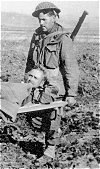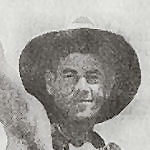| A TRUE DIGGER |  |
Fred Origlassi was according to his comrades "a great digger." One soldier says, "he was the spirit of his Platoon" which was 3 Platoon of A Co. 3 RAR.
A name like Origlassi does not evoke the typical digger. Nor did he himself at first sight. The typical digger should be a lean, tall, brown, weather-beaten bushie type with his slouch hat askew, ready to transform quickly, as though it came naturally, into a formidable fighting machine - a notion which is untenable to professionals.
Origlassi obviously didn't come from the bush. His Italian father came from Turin, in north Italy, early in the twentieth century to join the wave of "hard working, law abiding" Italian migrants who settled in Ingham in North Queensland where they saw opportunity. They worked in the cane industry and through sheer hard work and prudence became in one generation owners of cane farms. Theirs is one of Australia's great migrant success stories.
Fred Origlassi survived Syria and Tobruk, but at El Alamein, when Montgmery's Army faced the formidable Desert Corps led by Rommel, Fred, still suffering from a nasty illness called Black Desert Fever, was captured – on 17th July, 1942. El Alamein was in Italian territory so Fred first came under the control of Italians. To teach him that no Italian should be fighting against his own kin, he was strung up by his thumbs until his feet left the ground on several occasions.
Fred was relieved when he was handed over to the Germans and sent to a Stalag in Germany for the rest of the war. Fred's fellow prisoners tell how the big-hearted digger was ever ready to help others and would even save food for the more needy from his own meagre ration. Ironically, at about the time Fred was being tortured in North Africa, some Italian relatives in Australia were being interned as aliens.
The moment the war ended and Fred was freed, he and a mate commandeered a truck, to ransack a warehouse to get food for a starving German woman who had been kind to the pows.
Fred was demobilised on 2nd October 1945, but he did not return to Ingham.
We could surmise that he no longer felt so strongly about his Italian heritage. Perhaps the Battalion had become his home, his family and his identity.
He got a job at the Greenslopes Military Hospital, Brisbane and again his caring nature was observed, for it has been recorded that he helped Balkan refugees who were working at the hospital, by teaching them English. One day he went to the assistance of a beautiful girl convalescing from a serious illness. He fell in love with her, but aware of prejudice, he warned her that he had an Italian name, but (as though to rectify) he added he did have a French grandmother. Entranced by the warm- hearted, gentle man, the beautiful girl married him.
Then before Fred had had time to really enjoy his freedom, the Korean War broke out. Is it really to be wondered, knowing Fred Origlassi's experiences, that immediately volunteers were called for, he joined K Force, a special force enlisted for Korea, in order to ensure that the world would not again come under the sway of another form of tyranny? He was given the Queensland Number 1/40001, but because a mate didn't want his allotted number to have a nine in it, Fred gave him his prestigious "1" and became, instead, 1/40009.
Like Origlassi, there was another who was also a 2/32 man, a "Rat", in 3 RAR. The other "Rat," Arch Denness, who died in 1998, won an MC for his leadership of C Co's lead role in 3 RAR's first battle, Apple Orchard on 22nd October. Many in the battalion in 1950 and 1951 were older men who had singular AIF experience like Denness and Origlassi. It is they and their like who ensured the success of a battalion that was hastily put together and then plunged into the front line.
Fred, who was placed in A Co, enjoyed the distinction of being one who sailed from Japan to Korea on the "Aiken Victory," a proud claim, that signifies a man is an original, one who was among the first to hear the bugle call, as the ethos goes.
At Pusan, on 28th September 1950, they were met by Lt. Col Charles Green their CO. They were hastened to join the 27th British Commonwealth Brigade, led by Brigadier Aubrey Coad, to take the vanguard position of the US eighth Army's advance into North Korea. Fred in 3 Platoon, commanded by Lieutenant "Chic" Charlesworth, survived the three first important battles: Apple Orchard, Broken Bridge and Chongju. In this period, 3 RAR's reputation was established, and their style and prowess was recognised by the US 8th Army generals, who awarded some individual, well-earned decorations. Inexplicably, there were few Australian-recommended awards given in the early period.
When a quick victory was expected and all thought the war was nearly over, everything changed. On November 1st Lt. Col Charlie Green died of wounds sustained after the Battle of Chongju. This shock coincided with the Chinese entry into the war with a 300,000 strong army that sent the United Nations Army into a retreat that too often became a shambles. MacArthur said, "A new war has begun."
It was November 5th, Guy Fawkes day, when the next tragedy struck 3 RAR.
Positioned at the rear of the 8th Army in retreat, the 27th BCB faced a dire situation. They had already withdrawn close to the very spot at the Taenyong River where they had fought the Battle of the Broken Bridge on 25th October. The road they were withdrawing along had been cut by a Chinese force, entrenched on a ridge, overlooking the road.
Brigadier Coad ordered that the ridge be cleared, in order to open the road. The Argyll's (also part of 27 BCB) led the attack and were halted. The Australians were then sent in with A Co in the lead. At the start line, Vic Carr reported how inspiring it was to see the troops advancing across the open ground before they began to climb the ridge in a treacherous frontal attack with only mortar support. As they advanced, the Chinese rained fire on them. Immediately, casualties were taken but the Australians courageously persisted until the ridge was cleared and secured, as darkness fell.
Once it became dark, the Chinese, as is their practice, became active. They targeted the battalion's weak spots. The obvious one, Battalion Headquarters sited on the road, was put under heavy attack. The new, battle-inexperienced CO ordered a withdrawal. Military theory teaches that it is fatal to withdraw while under attack, let alone in the dark, a lesson that was reinforced on 5th November, and reverberates in the Battalion memory.
The A Co commander, Capt. Chitts, was wounded. His replacement obeyed the withdrawal order unquestioningly, whereas other companies recognised the peril and responded cautiously. Consequently, A Co. was chopped to pieces on that Guy Fawks night that stole the lives of too many brave men. A Co, who had the highest casualties, went into the Battle of Pakchon 110 strong, and came out with only 60 left standing. Altogether, sixteen were killed or died of wounds.
At the point when A Co was about to move out, Fred Origlassi leaned down to tell another soldier to get ready to move. As he spoke he was shot dead.
In Australia, Phyl, Origlassi's wife, had just lost a baby. Realising she had a potential for miscarrying, Phyl had not told Fred of the pregnancy, for fear of worrying him. On November the 8th, a telegram was handed to her in the hospital during a celebration arranged for her birthday. She hesitated to open it, thinking she'd wait for a quiet moment to read what she thought would be Fred's birthday wishes. Someone prevailed on her to open it. She recalls little else.
To later cause Phyl distress, she gave all Fred's pictures to his brother who was ill. The brother, before he died, sent the pictures to the War Memorial. Consequently, until recently she had no photos of Fred in Korea until she sighted a picture in a story that Snow Dicker submitted to a veterans' journal. In the picture Fred is typically caring for someone: he is acting as a stretcher bearer, with his rifle over one arm, and his helmet obviously tossed on his head in a great hurry.
As naturally as it seems for an Australian to become a great soldier, so it was for Fred Origlassi.. Fred's rich and proud Italian-Australian heritage was subsumed when he became a digger. He had learned the incommunicable that only a member of a great fighting battalion can ever know. He had discovered a bond that only blood sacrifice can create. He had experienced what Jo Gullett calls, in his classic memoir, Not as Duty Only, "a state of grace."
Fred's comrades will always remember him as a soldier with the ultimate identity –
"a great digger."
|  |
Olwyn Green, 2000
- Based on
- "The Last Call of the Bugle", Jack Gallaway,
- "The Oxford Companion to Australian History"
- "Old Faithful", July, 1999 ed.
- Interviews:
- Phyl Hambling, ( widow of Fred Origlassi)
- Mick Servos, A Co., wounded at Pakchon.
|
|
